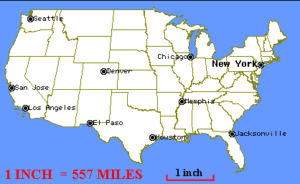Learning Objectives
- Solve rational equations
- Solve rational equations by clearing denominators
- Identify extraneous solutions in a rational equation
- Solve for a variable in a rational formula
- Applications of rational equations
- Identify the components of a work equation
- Solve a work equation
- Define and write a proportion
- Solve proportional problems involving scale drawings
- Define direct variation, and solve problems involving direct variation
- Define inverse variation and solve problems involving inverse variation
- Define joint variation and solve problems involving joint variation
Equations that contain rational expressions are called rational equations. For example, [latex] \frac{2x+1}{4}=\frac{x}{3}[/latex] is a rational equation. Rational equations can be useful for representing real-life situations and for finding answers to real problems. In particular, they are quite good for describing a variety of proportional relationships.
One of the most straightforward ways to solve a rational equation is to eliminate denominators with the common denominator, then use properties of equality to isolate the variable. This method is often used to solve linear equations that involve fractions as in the following example:
Solve [latex]\frac{1}{2}x-3=2-\frac{3}{4}x[/latex] by clearing the fractions in the equation first.
Multiply both sides of the equation by 4, the common denominator of the fractional coefficients.
[latex]\begin{array}{c}\frac{1}{2}x-3=2-\frac{3}{4}x\\ 4\left(\frac{1}{2}x-3\right)=4\left(2-\frac{3}{4}x\right)\\\text{}\\\,\,\,\,4\left(\frac{1}{2}x\right)-4\left(3\right)=4\left(2\right)+4\left(-\frac{3}{4}x\right)\\2x-12=8-3x\\\underline{+3x}\,\,\,\,\,\,\,\,\,\,\,\,\,\,\,\,\,\,\,\,\,\,\,\underline{+3x}\\5x-12=8\,\,\,\,\,\,\,\,\\\,\,\,\,\,\,\,\underline{+12}\,\,\,\,\underline{+12} \\5x=20\\x=4\end{array}[/latex]
We could have found a common denominator and worked with fractions, but that often leads to more mistakes. We can apply the same idea to solving rational equations. The difference between a linear equation and a rational equation is that rational equations can have polynomials in the numerator and denominator of the fractions. This means that clearing the denominator may sometimes mean multiplying the whole rational equation by a polynomial. In the next example, we will clear the denominators of a rational equation with a terms that has a polynomial in the numerator.
Example
Solve the equation [latex] \frac{x+5}{8}=\frac{7}{4}[/latex].
In the next example, we show how to solve a rational equation with a binomial in the denominator of one term. We will use the common denominator to eliminate the denominators from both fractions. Note that the LCD is the product of both denominators because they don’t share any common factors.
Example
Solve the equation [latex] \frac{8}{x+1}=\frac{4}{3}[/latex].
You could also solve this problem by multiplying each term in the equation by 3 to eliminate the fractions altogether. Here is how it would look.
Example
Solve the equation [latex]\frac{x}{3}+1=\frac{4}{3}[/latex].
In the video that follows we present two ways to solve rational equations with both integer and variable denominators.
Excluded Values and Extraneous Solutions
Some rational expressions have a variable in the denominator. When this is the case, there is an extra step in solving them. Since division by 0 is undefined, you must exclude values of the variable that would result in a denominator of 0. These values are called excluded values. Let’s look at an example.
Example
Solve the equation [latex] \frac{2x-5}{x-5}=\frac{15}{x-5}[/latex].
In the following video we present an example of solving a rational equation with variables in the denominator.
You’ve seen that there is more than one way to solve rational equations. Because both of these techniques manipulate and rewrite terms, sometimes they can produce solutions that don’t work in the original form of the equation. These types of answers are called extraneous solutions. That’s why it is always important to check all solutions in the original equations—you may find that they yield untrue statements or produce undefined expressions.
Example
Solve the equation [latex] \frac{16}{m+4}=\frac{{{m}^{2}}}{m+4}[/latex].
Rational formulas
Rational formulas can be useful tools for representing real-life situations and for finding answers to real problems. Equations representing direct, inverse, and joint variation are examples of rational formulas that can model many real-life situations. As you will see, if you can find a formula, you can usually make sense of a situation.
When solving problems using rational formulas, it is often helpful to first solve the formula for the specified variable. For example, work problems ask you to calculate how long it will take different people working at different speeds to finish a task. The algebraic models of such situations often involve rational equations derived from the work formula, [latex]W=rt[/latex]. The amount of work done (W) is the product of the rate of work (r) and the time spent working (t). Using algebra, you can write the work formula 3 ways:
[latex]W=rt[/latex]
Find the time (t): [latex] t=\frac{W}{r}[/latex] (divide both sides by r)
Find the rate (r): [latex] r=\frac{W}{t}[/latex](divide both sides by t)
Example
The formula for finding the density of an object is [latex] D=\frac{m}{v}[/latex], where D is the density, m is the mass of the object and v is the volume of the object. Rearrange the formula to solve for the mass (m) and then for the volume (v).
Now let’s look at an example using the formula for the volume of a cylinder.
Example
The formula for finding the volume of a cylinder is [latex]V=\pi{r^{2}}h[/latex], where V is the volume, r is the radius and h is the height of the cylinder. Rearrange the formula to solve for the height (h).
In the following video we give another example of solving for a variable in a formula, or as they are also called, a literal equation.
Applications of Rational Equations
Rational equations can be used to solve a variety of problems that involve rates, times and work. Using rational expressions and equations can help you answer questions about how to combine workers or machines to complete a job on schedule.

A Good Day’s Work
Work
A “work problem” is an example of a real life situation that can be modeled and solved using a rational equation. Work problems often ask you to calculate how long it will take different people working at different speeds to finish a task. The algebraic models of such situations often involve rational equations derived from the work formula, [latex]W=rt[/latex]. (Notice that the work formula is very similar to the relationship between distance, rate, and time, or [latex]d=rt[/latex].) The amount of work done (W) is the product of the rate of work (r) and the time spent working (t). The work formula has 3 versions.
[latex]\begin{array}{l}W=rt\\\\\,\,\,\,\,t=\frac{W}{r}\\\\\,\,\,\,\,r=\frac{W}{t}\end{array}[/latex]
Some work problems include multiple machines or people working on a project together for the same amount of time but at different rates. In that case, you can add their individual work rates together to get a total work rate. Let’s look at an example.
Example
Myra takes 2 hours to plant 50 flower bulbs. Francis takes 3 hours to plant 45 flower bulbs. Working together, how long should it take them to plant 150 bulbs?
Other work problems go the other way. You can calculate how long it will take one person to do a job alone when you know how long it takes people working together to complete the job.
Example
Joe and John are planning to paint a house together. John thinks that if he worked alone, it would take him 3 times as long as it would take Joe to paint the entire house. Working together, they can complete the job in 24 hours. How long would it take each of them, working alone, to complete the job?
In the video that follows, we show another example of finding one person’s work rate given a combined work rate.
As shown above, many work problems can be represented by the equation [latex] \frac{t}{a}+\frac{t}{b}=1[/latex], where t is the time to do the job together, a is the time it takes person A to do the job, and b is the time it takes person B to do the job. The 1 refers to the total work done—in this case, the work was to paint 1 house.
The key idea here is to figure out each worker’s individual rate of work. Then, once those rates are identified, add them together, multiply by the time t, set it equal to the amount of work done, and solve the rational equation.
We present another example of two people painting at different rates in the following video.
Proportions

Matryoshka, or nesting dolls.
A proportion is a statement that two ratios are equal to each other. There are many things that can be represented with ratios, including the actual distance on the earth that is represented on a map. In fact, you probably use proportional reasoning on a regular basis and don’t realize it. For example, say you have volunteered to provide drinks for a community event. You are asked to bring enough drinks for 35-40 people. At the store you see that drinks come in packages of 12. You multiply 12 by 3 and get 36 – this may not be enough if 40 people show up, so you decide to buy 4 packages of drinks just to be sure.
This process can also be expressed as a proportional equation and solved using mathematical principles. First, we can express the number of drinks in a package as a ratio:
[latex]\frac{12\text{ drinks }}{1\text{ package }}[/latex]
Then we express the number of people who we are buying drinks for as a ratio with the unknown number of packages we need. We will use the maximum so we have enough.
[latex]\frac{40\text{ people }}{x\text{ packages }}[/latex]
We can find out how many packages to purchase by setting the expressions equal to each other:
[latex]\frac{12\text{ drinks }}{1\text{ package }}=\frac{40\text{ people }}{x\text{ packages }}[/latex]
To solve for x, we can use techniques for solving linear equations, or we can cross multiply as a shortcut.
[latex]\begin{array}{l}\,\,\,\,\,\,\,\frac{12\text{ drinks }}{1\text{ package }}=\frac{40\text{ people }}{x\text{ packages }}\\\text{}\\x\cdot\frac{12\text{ drinks }}{1\text{ package }}=\frac{40\text{ people }}{x\text{ packages }}\cdot{x}\\\text{}\\\,\,\,\,\,\,\,\,\,\,\,\,\,\,\,\,\,\,\,\,\,\,\,\,\,12x=40\\\text{}\\\,\,\,\,\,\,\,\,\,\,\,\,\,\,\,\,\,\,\,\,\,\,\,\,\,\,\,\,\,\,\,x=\frac{40}{12}=\frac{10}{3}=3.33\end{array}[/latex]
We can round up to 4 since it doesn’t make sense to by 0.33 of a package of drinks. Of course, you don’t write out your thinking this way when you are in the grocery store, but doing so helps you to be able to apply the concepts to less obvious problems. In the following example we will show how to use a proportion to find the number of people on teh planet who don’t have access to a toilet.
Example
As of March, 2016 the world’s population was estimated at 7.4 billion. [1]. According to water.org, 1 out of every 3 people on the planet lives without access to a toilet. Find the number of people on the planet that do not have access to a toilet.
In the next example, we will use the length of a person’t femur to estimate their height. This process is used in forensic science and anthropology, and has been found in many scientific studies to be a very good estimate.
Example
It has been shown that a person’s height is proportional to the length of their femur [2]. Given that a person who is 71 inches tall has a femur length of 17.75 inches, how tall is someone with a femur length of 16 inches?
Another way to describe the ratio of femur length to height that we found in the last example is to say there’s a 1:4 ratio between femur length and height, or 1 to 4.
Ratios are also used in scale drawings. Scale drawings are enlarged or reduced drawings of objects, buildings, roads, and maps. Maps are smaller than what they represent and a drawing of dendritic cells in your brain is most likely larger than what it represents. The scale of the drawing is a ratio that represents a comparison of the length of the actual object and it’s representation in the drawing. The image below shows a map of the us with a scale of 1 inch representing 557 miles. We could write the scale factor as a fraction [latex]\frac{1}{557}[/latex] or as we did with the femur-height relationship, 1:557.

Map with scale factor
In the next example we will use the scale factor given in the image above to find the distance between Seattle Washington and San Jose California.
Example
Given a scale factor of 1:557 on a map of the US, if the distance from Seattle, WA to San Jose, CA is 1.5 inches on the map, define a proportion to find the actual distance between them.
In the next example, we will find a scale factor given the length between two cities on a map, and their actual distance from each other.
Example
Two cities are 2.5 inches apart on a map. Their actual distance from each other is 325 miles. Write a proportion to represent and solve for the scale factor for one inch of the map.
The video that follows show another example of finding an actual distance using the scale factor from a map.
In the video that follows, we present an example of using proportions to obtain the correct amount of medication for a patient, as well as finding a desired mixture of coffees.
Variation

So many cars, so many tires.
Direct Variation
Variation equations are examples of rational formulas and are used to describe the relationship between variables. For example, imagine a parking lot filled with cars. The total number of tires in the parking lot is dependent on the total number of cars. Algebraically, you can represent this relationship with an equation.
[latex]\text{number of tires}=4\cdot\text{number of cars}[/latex]
The number 4 tells you the rate at which cars and tires are related. You call the rate the constant of variation. It’s a constant because this number does not change. Because the number of cars and the number of tires are linked by a constant, changes in the number of cars cause the number of tires to change in a proportional, steady way. This is an example of direct variation, where the number of tires varies directly with the number of cars.
You can use the car and tire equation as the basis for writing a general algebraic equation that will work for all examples of direct variation. In the example, the number of tires is the output, 4 is the constant, and the number of cars is the input. Let’s enter those generic terms into the equation. You get [latex]y=kx[/latex]. That’s the formula for all direct variation equations.
[latex]\text{number of tires}=4\cdot\text{number of cars}\\\text{output}=\text{constant}\cdot\text{input}[/latex]
Example
Solve for k, the constant of variation, in a direct variation problem where [latex]y=300[/latex] and [latex]x=10[/latex].
In the video that follows, we present an example of solving a direct variation equation.
Inverse Variation
Another kind of variation is called inverse variation. In these equations, the output equals a constant divided by the input variable that is changing. In symbolic form, this is the equation [latex] y=\frac{k}{x}[/latex].
One example of an inverse variation is the speed required to travel between two cities in a given amount of time.
Let’s say you need to drive from Boston to Chicago, which is about 1,000 miles. The more time you have, the slower you can go. If you want to get there in 20 hours, you need to go 50 miles per hour (assuming you don’t stop driving!), because [latex] \frac{1,000}{20}=50[/latex]. But if you can take 40 hours to get there, you only have to average 25 miles per hour, since [latex] \frac{1,000}{40}=25[/latex].
The equation for figuring out how fast to travel from the amount of time you have is [latex] speed=\frac{miles}{time}[/latex]. This equation should remind you of the distance formula [latex] d=rt[/latex]. If you solve [latex] d=rt[/latex] for r, you get [latex] r=\frac{d}{t}[/latex], or [latex] speed=\frac{miles}{time}[/latex].
In the case of the Boston to Chicago trip, you can write [latex] s=\frac{1,000}{t}[/latex]. Notice that this is the same form as the inverse variation function formula, [latex] y=\frac{k}{x}[/latex].
Example
Solve for k, the constant of variation, in an inverse variation problem where [latex]x=5[/latex] and [latex]y=25[/latex].
In the next example, we will find the water temperature in the ocean at a depth of 500 meters. Water temperature is inversely proportional to depth in the ocean.

Water temperature in the ocean varies inversely with depth.
Example
The water temperature in the ocean varies inversely with the depth of the water. The deeper a person dives, the colder the water becomes. At a depth of 1,000 meters, the water temperature is 5º Celsius. What is the water temperature at a depth of 500 meters?
In the video that follows, we present an example of inverse variation.
Joint Variation
A third type of variation is called joint variation. Joint variation is the same as direct variation except there are two or more quantities. For example, the area of a rectangle can be found using the formula [latex]A=lw[/latex], where l is the length of the rectangle and w is the width of the rectangle. If you change the width of the rectangle, then the area changes and similarly if you change the length of the rectangle then the area will also change. You can say that the area of the rectangle “varies jointly with the length and the width of the rectangle.”
The formula for the volume of a cylinder, [latex]V=\pi {{r}^{2}}h[/latex] is another example of joint variation. The volume of the cylinder varies jointly with the square of the radius and the height of the cylinder. The constant of variation is [latex] \pi [/latex].
Example
The area of a triangle varies jointly with the lengths of its base and height. If the area of a triangle is 30 inches[latex]^{2}[/latex] when the base is 10 inches and the height is 6 inches, find the variation constant and the area of a triangle whose base is 15 inches and height is 20 inches.
Finding k to be [latex] \frac{1}{2}[/latex] shouldn’t be surprising. You know that the area of a triangle is one-half base times height, [latex] A=\frac{1}{2}bh[/latex]. The [latex] \frac{1}{2}[/latex] in this formula is exactly the same [latex] \frac{1}{2}[/latex] that you calculated in this example!
In the following video, we show an example of finding the constant of variation for a jointly varying relation.
Direct, Joint, and Inverse Variation
k is the constant of variation. In all cases, [latex]k\neq0[/latex].
- Direct variation: [latex]y=kx[/latex]
- Inverse variation: [latex] y=\frac{k}{x}[/latex]
- Joint variation: [latex]y=kxz[/latex]
Summary
Rational formulas can be used to solve a variety of problems that involve rates, times, and work. Direct, inverse, and joint variation equations are examples of rational formulas. In direct variation, the variables have a direct relationship—as one quantity increases, the other quantity will also increase. As one quantity decreases, the other quantity decreases. In inverse variation, the variables have an inverse relationship—as one variable increases, the other variable decreases, and vice versa. Joint variation is the same as direct variation except there are two or more variables.
Summary
You can solve rational equations by finding a common denominator. By rewriting the equation so that all terms have the common denominator, you can solve for the variable using just the numerators. Or, you can multiply both sides of the equation by the least common multiple of the denominators so that all terms become polynomials instead of rational expressions.
An important step in solving rational equations is to reject any extraneous solutions from the final answer. Extraneous solutions are solutions that don’t satisfy the original form of the equation because they produce untrue statements or are excluded values that make a denominator equal to 0.
- "Current World Population." World Population Clock: 7.4 Billion People (2016). Accessed June 21, 2016. http://www.worldometers.info/world-population/. "Current World Population." World Population Clock: 7.4 Billion People (2016). Accessed June 21, 2016. http://www.worldometers.info/world-population/. "Current World Population." World Population Clock: 7.4 Billion People (2016). Accessed June 21, 2016. http://www.worldometers.info/world-population/. ↵
- Obialor, Ambrose, Churchill Ihentuge, and Frank Akapuaka. "Determination of Height Using Femur Length in Adult Population of Oguta Local Government Area of Imo State Nigeria." Federation of American Societies for Experimental Biology, April 2015. Accessed June 22, 2016. http://www.fasebj.org/content/29/1_Supplement/LB19.short. ↵